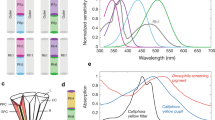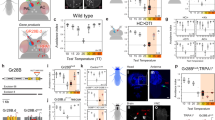Abstract
The genetic dissection of Drosophila audition is advancing considerably1,2,3,4, but complementary studies are needed to unravel the chain of mechanosensory events that bring about hearing in the fly3. Here we investigate the delicate biomechanics of the fly's minute antennal hearing organs and show that they look and work like a lock and key. Rotating in response to sound, the antenna's distal segment mechanically activates the auditory receptors — thereby 'unlocking' the mechanism of Drosophila audition.
Similar content being viewed by others
Main
In Drosophila melanogaster, the antennae mediate the detection of conspecific 'love songs'5,6. Anatomically, each antenna is an asymmetric structure consisting of three segments and a feather-like arista3 (Fig. 1a). Laser vibrometric analysis of sound-induced vibrations7 reveals that the arista and the club-shaped third segment together constitute a mechanical entity — the sound receiver. Both antennal parts oscillate sympathetically in response to acoustic stimulation, consistently exhibiting a moderately damped resonance at 426 ± 16 Hz (quality factor, Q = 1.2 ± 0.1; 8 flies; Fig. 1b).
a, Anatomy. Left panel, scanning electron micrograph showing the three antennal segments (numbered) and the arista; right panel, longitudinal section through segments 2 and 3. Scale bars, 100 μm. b, Mechanical response to acoustic random-noise stimulation. The arista and the third segment exhibit identical resonance characteristics and rotate about the longitudinal axis of the latter. Frequency spectra show the magnitude and phase of the vibration velocity (measured by microscanning laser Doppler vibrometry7) normalized to the particle velocity in the sound field (measured by a particle-velocity microphone at the antenna's position7). A response magnitude of unity indicates equal vibration velocity and particle velocity, and a phase of + 90° means that the vibration velocity leads the particle velocity by one-quarter of an oscillation cycle. The acoustic stimulus (mean particle velocity ± 0.04 mm s−1) induced maximal displacements of ± 20 nm and rotation of ± 0.003°. Insets, measurement sites and colour convention (drawing by P. Bryant10). c, Operational mode, showing analogy between antennal mechanics and a rotating key. Yellow arrows, input force; blue arrows, rotation; red arrows, output force.
Mechanical measurements at different locations (Fig. 1b) show that the entire arista oscillates as a stiff rod, with its vibration velocity continuously decreasing from tip to base. Remarkably, this oscillation is accompanied by rotation of the third segment. The 180° phase shift between the mechanical responses of opposite edges (Fig. 1b) unambiguously shows that they move in opposite directions and that this segment rotates about its longitudinal axis. This rotation is a direct consequence of the radial orientation of the arista, which breaks mechanical symmetry. Physically, the arista introduces a moment arm, increases the effective surface area, and thus determines the twisting force (torque) exerted by sound.
When stimulated acoustically, the third segment rotates like the bow of a key (Fig. 1c). Moreover, the proximal part of this segment presents a stalk that fits into a pit in the second segment, like a key in its lock. Extending along the rotational axis, this stalk transmits the rotation 'downstream', like a key's stem (Fig. 1a, c). Before connecting to the second segment, the stalk bends, forming a hook. This hook then oscillates like a key's bit (Fig. 1a, c). This vibration will maximally stretch and compress the auditory receptors which, notably, are attached perpendicularly to both sides of the hook.
Unlike other animals, Drosophila makes use of sound-induced rotation to channel acoustic energy to its auditory receptor neurons — it has 'rotational ears'. This unconventional mechanism relies on a simple trick: the hook balances the asymmetry introduced by the arista, thereby guaranteeing a receptor activation that compares to that in other insect auditory systems8. The third segment of the Drosophila antenna is also the primary organ of olfaction and carries hundreds of olfactory sensilla9. As hearing relies on rotation, the two sensory modalities can co-exist without compromising their respective functions. Such an evolutionary solution is elegant; flies did not turn their nose into an ear, they turn their nose to hear.
References
Kernan, M., Cowan, D. & Zuker C. Neuron 12, 1195–1206 (1994).
Eberl, D. F., Duyk, G. M. & Perrimon, N. Proc. Natl Acad. Sci. USA 94, 14837–14842 (1997).
Eberl, D. F., Hardy, R. W. & Kernan, M. J. J. Neurosci. 20, 5981–5988 (2000).
Walker, R., Willingham, A. & Zuker C. Science 287, 2229–2234 (2000).
Bennet-Clark, H. C. Nature 234, 255–259 (1971).
Hall, J. C. Science 264, 1702–1714 (1994).
Göpfert, M. C. & Robert, D. Proc. R. Soc. Lond. B 267, 453–457 (2000).
Yager, D. D. Microsc. Res. Tech. 47, 380–400 (1999).
Carlson, J. R. Trends Genet. 12, 175–180 (1996).
FlyBase consortium (http://flybase.bio.indiana.edu) Nucleic Acids Res. 27, 85–88 (1999).
Author information
Authors and Affiliations
Corresponding author
Rights and permissions
About this article
Cite this article
Göpfert, M., Robert, D. Turning the key on Drosophila audition. Nature 411, 908 (2001). https://doi.org/10.1038/35082144
Issue Date:
DOI: https://doi.org/10.1038/35082144
This article is cited by
-
From bristle to brain: embryonic development of topographic projections from basiconic sensilla in the antennal nervous system of the locust Schistocerca gregaria
Development Genes and Evolution (2024)
-
Central projections from Johnston’s organ in the locust: Axogenesis and brain neuroarchitecture
Development Genes and Evolution (2023)
-
Memory of social experience affects female fecundity via perception of fly deposits
BMC Biology (2022)
-
Early embryonic development of Johnston’s organ in the antenna of the desert locust Schistocerca gregaria
Development Genes and Evolution (2022)
-
Epithelial domains and the primordial antennal nervous system of the embryonic grasshopper Schistocerca gregaria
Invertebrate Neuroscience (2020)
Comments
By submitting a comment you agree to abide by our Terms and Community Guidelines. If you find something abusive or that does not comply with our terms or guidelines please flag it as inappropriate.




